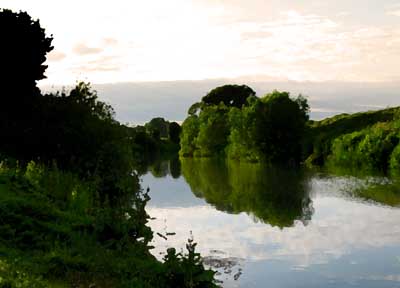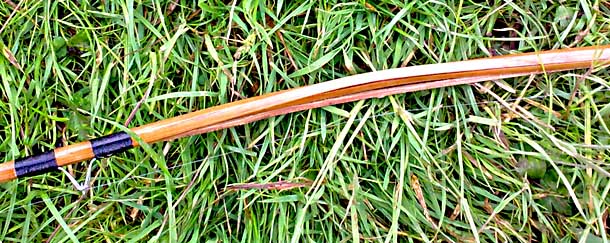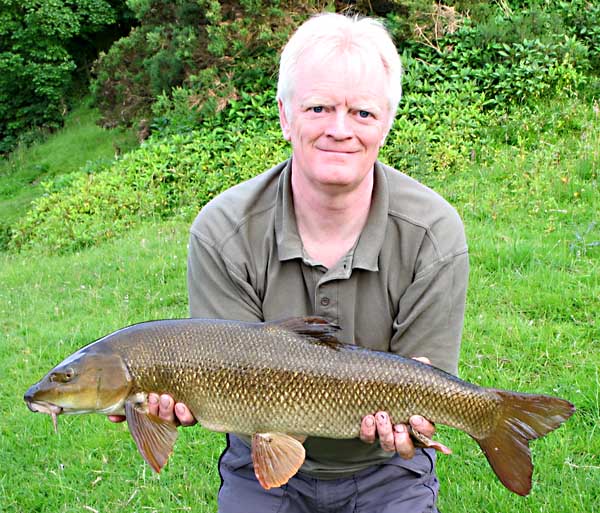Late afternoon on the Swale
Brrt…. brrt…. brrt…. The distinctive ratchet on the Gypsy d’Or signalled a slight advantage to the barbel, but its progress towards the sanctuary of the far bank had now slowed to a snail’s pace. The result of this battle was now in the balance, but whatever happened it was going to take some time.
 Thursday 2nd July, exactly one week after the events of my last article and I’m back fishing the gulley swim. I’d left a client’s factory in Brighouse at 3 o’clock and stopped in Morrison’s in Boroughbridge for some sandwiches on the way up so I didn’t get fishing until nearly 5 o’clock.
Thursday 2nd July, exactly one week after the events of my last article and I’m back fishing the gulley swim. I’d left a client’s factory in Brighouse at 3 o’clock and stopped in Morrison’s in Boroughbridge for some sandwiches on the way up so I didn’t get fishing until nearly 5 o’clock.
Tactics were exactly the same as last time with a small pellet feeder dropped against a far bank bush and one positioned into the gulley. This time I had a fish almost straight away from the bush, a cracking barbel of 7lb 15oz. As I returned it, I felt the first few drops of the forecast rain, so I decided to nip back to the car for my brolly. On the way I spied Mick Wood disappearing over the stile, so I dropped the brolly back at my swim and followed him upstream for a chat. It turns out that by thinking about our fishing we’ve both had an excellent start to the season despite the difficult conditions. We chewed the fat for a while before I set off back to my swim in a steady drizzle.
Up went the brolly, out went the baits and I settled back to enjoy my tea. Half an hour later the tip of the gulley rod pulled steadily round and battle commenced. Instead of the usual downstream dash this fish made a sharp turn and headed up and across towards a real snag pit of a bush. If it made it I was lost….
I was now starting to get worried, but I was exerting as much pressure as I dared and I forced myself to be patient. The problem was that the fish had kept deep and I couldn’t judge just how close to the bush it was. I swung the rod upstream to try to get a better angle, but the fish was now fixated on the bush and it maintained its dogged progress. Then the inevitable happened and I felt a deadening of the sensations down the line as my feeder snagged on something. My only option was to clamp down tight, denying the fish any further progress and hopefully pulling the feeder free.
Have you ever trodden on a snail? The sickening crunch is slightly less bad than the farty pop you get if you tread on a frog, but it’s still not nice.
I heard the sound of treading on the mother of all snails as the middle section of my 60 year old rod burst apart, forming a cat’s cradle of cane strips.

Ouch!
“Oh dear, how unfortunate.” Or words to that effect.
“Are y’all right lad?”
The guy downstream had heard the commotion and come to investigate. Things were obviously not alright, but I suppose words like “You’re obviously stuffed” would have seemed a little harsh.
Luckily the feeder came free and the barbel kited downstream to sulk beneath a bush that didn’t have quite the same snag index as the other one.
“That looks expensive.”
Well not in monetary terms, but definitely in emotional trauma.
No point crying over ruptured cane; I kept the pressure on. The fish gave ground slowly, ratcheting up my blood pressure with heavy shakes of its head. I worked it slowly back towards me keeping a light pressure on the drum of the reel if it decided to run. Finally I pulled it over the net and collapsed in my chair.
“Looks like a double.”
Once I’d recovered I confirmed this with a weight of 10lb 2oz.

My favourite rod had started out around 60 years ago as a salmon or sea trout fly rod. I’d bought it off Ebay as ‘an 11ft float rod’, but a bit of experimentation had confirmed both its likely ancestry and its potential as a barbel rod. I stripped and rebuilt it, but decided that it looked better without the intermediate whippings and so I left them off. The rod had confirmed its ability with barbel of 9lb 14oz, 8lb 11oz and 6lb 15oz in the space of a few days, before finally succumbing to the 10lb 2oz fish.
60 years ago cane fly rods operated at the limit of the glues available and the middle sections of these rods were the most highly stressed. The glue had obviously begun to fail deep within the structure of the cane and the stresses of playing large, hard fighting barbel had completed the work.
 |
| The rod in better days |
But what a way to go!
Goodbye old friend – enjoy your time in that vegetable patch in the sky.
An hour later the bland, modern efficiency of aerospace technology extracted a barbel of around 7lb (see header pic) with a minimum of fuss, but not quite the same level of enjoyment.













